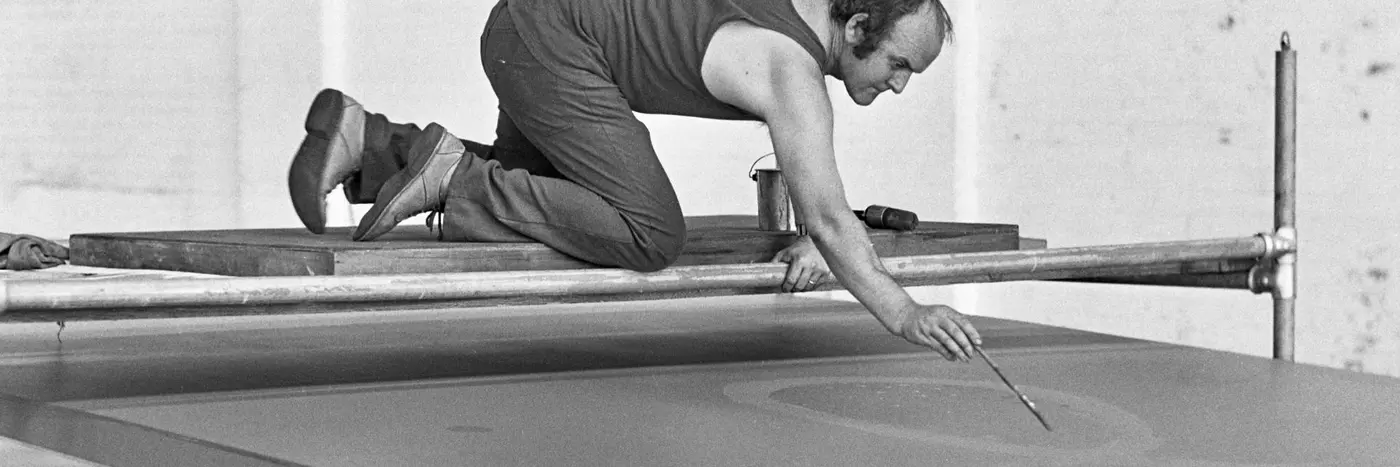How Olsen was seduced by the charms of Australia’s largest city
It was in 1935 that John Olsen succumbed to Sydney’s irresistible spell. He was seven years old, and his family had moved from Newcastle to a flat in Curlewis Street, Bondi.
Down at the beach at the end of the street, Olsen and a tribe of mates would spend their free time chasing crabs, popping bluebottles and exploring tidal rock pools.
Unbeknown to the fledgling artist, who was already drawing pictures on every available surface, he was busily creating an intimate knowledge of the salt-encrusted Sydney seaboard and the minutiae of its natural life. They were memories that stayed with him all his long life.
As an adult, Olsen’s relationship with the city deepened and widened. He would compare Sydney to a mistress, not the submissive kind but a wilful one with a sharp tongue and some dangerous associates.
“I’ve always thought of the formation of Sydney’s land forms as a bitch goddess and frankly at times it frightens me,” the artist wrote in 1973.
“The breasty contours of its hills … when your [sic] sailing through the heads you feel as though your [sic] sailing through her arms … And when you are coming into her you feel you are going deeper and you are caught in her spidery net.”
In the best tradition of goddesses, Sydney could be blatantly two-faced. Languidly glamorous under a blazing sun, the city was also an unashamed larrikin.
Olsen, who died in April, aged 95, found the duality irresistible. Critic Robert Hughes would write that Olsen saw “hedonism and scepticism as two sides of the Sydney coin”.
Like all our great artists, from Streeton to Whiteley, Olsen portrayed our city to us through the lens of his unique understanding and vision. That vision is made palpable in some of the paintings that will float across the surface of the Opera House sails in the annual Lighting of the Sails for Vivid Sydney.
Entrance to the Seaport of Desire and Sydney Sun, painted in 1964 and 1965, have both been selected to display on the sails. But perhaps the highlight of the light show will be when Olsen’s career-defining Sydney Opera House mural, the huge (274 x 2153 cm) Salute to Slessor’s 5 Bells, 1972-73, glides across Jørn Utzon’s brilliant white roof.
Salute to Slessor’s 5 Bells was inspired by Olsen’s knowledge that Sydney Harbour was breathtaking, but that it could also hold dread secrets. Poet Kenneth Slessor’s friend Joe Lynch went overboard from a ferry on the harbour one night, and his body was never found.
Just how easily this fate could have befallen the artist himself was revealed when he spoke to the author in 2015.
“When we were students at Julian Ashton’s art school, we used to love to go on the ferry when it was rough weather in winter,” Olsen said. “We used to love to be not in the cabin but in the front part of the boat, which was a very dangerous thing at the time because the sea often runs over the front of the ferry.”
Olsen’s work might at first seem puzzling to viewers. But the key to unlocking his imagery is to let go of orthodox ways of seeing: to approach his work more openly, or everything everywhere all at once, to borrow the name of a recent movie.
In his 2020 memoir, Son of the Brush, Olsen’s son Tim explained that in his father’s work “the eye is constantly seduced and moved around the image”.
“His work’s influences go back to the tradition of ancient Chinese painting and the art of the continuous scroll, where the image is rolled out and portrayed in a continuous simultaneous vision, where we rest at no particular point,” Tim Olsen wrote.
“We are perpetually travelling and navigating through pictorial space ... All this in turn becomes a metaphor for the odyssey of our lives.”
Olsen himself gave another clue to interpreting his work when he wrote in his Opera House journal: “I like to be in the middle of a buzzing honey pot of images changing and evolving ... I like painting to have a human unpredictability”.
The artist lived in some of Sydney’s most spectacular locations, and drew full inspiration from all of them.
In 1963, Olsen and his wife Valerie and their young family moved to a former fisherman’s cottage in idyllic Watsons Bay. Olsen rented another cottage nearby for a studio, from where he could see and paint the harbour in all weathers and at all times of day and night.
The artist swam every morning in nearby Camp Cove, a stunningly beautiful location on Sydney Harbour near the swell and might of Sydney Heads. The city’s row of skyscrapers glitters in the distance.
Other Sydney locations where Olsen lived included Clareville Beach in Pittwater, Pearl Beach, Kings Cross, Paddington and Balmain. Olsen referred to himself as “blotting paper”, absorbing environments very quickly. Certainly, Sydney has never looked the same since Olsen unleashed his own interpretation.
“Olsen created Sydney – its harbour, life, vulgarity, beauty and movement – in the way that Drysdale created the outback,” critic Laurie Thomas wrote. “His landscape teems with people, with traffic, stop-go signs flashing, pubs, drinkers, circuses, everything, seen not from one point of view but from all points of view and as though everything from morning till night was happening at once.”
The Lighting of the Sails is very much a part of that panoply of Sydney’s nightlife, and Olsen for one was chuffed to know he would be a part of it.
Read more about John Olsen at the Sydney Opera House
